
In this section, we explore pivotal moments that shape the narrative and the psychological state of the boys stranded on an isolated island. The unfolding events highlight crucial decisions, escalating tensions, and the influence of fear on human behavior. Through these interactions, the novel’s central themes begin to take on more significance, drawing attention to the characters’ evolving responses to their environment and each other.
As the plot deepens, leadership dynamics become more pronounced, and the fear of an imagined force begins to disrupt their sense of order. The tension between maintaining civilization and surrendering to primal instincts reaches a critical point, affecting how individuals and groups respond to challenges. The symbolism embedded in these moments serves to underscore the conflict between reason and savagery, further advancing the narrative’s psychological complexity.
Key Insights from Chapter 6
This section of the narrative marks a critical turning point where fear and chaos intensify among the boys. The unexpected appearance of a dead parachutist is mistaken for the beast, escalating the group’s paranoia and distrust. This misunderstanding fuels further division between those clinging to order and those giving in to primitive instincts. As tensions rise, leadership dynamics begin to shift, revealing underlying fears and desires that will play a pivotal role in the story’s progression.
One of the central themes explored here is the duality of human nature. The boys’ reactions to perceived threats expose the tension between rational thought and emotional impulses. The symbolism of the beast, coupled with the arrival of the parachutist, highlights the internal struggles that each character faces. The unfolding events in this part of the story set the stage for greater conflicts, both external and internal, as the boys continue to navigate their descent into savagery.
Summary of Key Events in Chapter 6
In this segment, the tension among the boys escalates as a mysterious event disrupts their fragile sense of order. The group is gripped by fear when a parachutist’s body lands on the island, and the boys mistakenly interpret it as a sign of an evil presence lurking in the jungle. This marks a significant moment of misunderstanding, fueling paranoia and distrust, especially among the younger boys.
Misinterpretation of the Parachutist
As the body of the parachutist drifts onto the island, his parachute gets caught in the branches, causing him to appear as though he is floating in mid-air. Sam and Eric, on watch duty, see the figure and panic, believing it to be the beast. Their report spreads quickly, and the boys’ fear intensifies, deepening the divide between those who wish to maintain order and those who are succumbing to their darker impulses.
Leadership and Fear’s Impact
The appearance of the parachutist also plays a role in exacerbating the conflict between Ralph and Jack. Ralph’s attempts to keep the group focused on building a signal fire and maintaining order clash with Jack’s increasing focus on hunting and giving into fear. As the boys’ grip on rationality slips, the battle between civilization and savagery becomes more pronounced.
Important Themes in Chapter 6
This section of the narrative introduces several key themes that deepen the exploration of human nature and societal collapse. As fear spreads and tensions rise, the boys are forced to confront both internal and external threats. These themes not only highlight the characters’ psychological transformations but also reveal how their environment shapes their behavior. The arrival of the parachutist and the escalating paranoia offer significant insights into the darker aspects of the boys’ lives on the island.
Fear and Its Influence on Behavior
Fear becomes one of the dominant forces in this part of the story. The boys’ collective anxiety over the imagined presence of a beast causes irrational decisions, driving wedges between them. The idea of the unknown, fueled by fear, leads to impulsive actions, which are often based on superstition rather than reality. This theme illustrates how fear can manipulate perceptions and ultimately control the actions of individuals and groups.
Loss of Innocence
As the boys’ fear intensifies, their sense of innocence begins to erode. The once playful and cooperative group increasingly gives way to distrust and violence. This theme reveals how quickly the veneer of civility can dissolve in the face of survival instincts and how fear can hasten the loss of childhood innocence. Their descent into chaos becomes a powerful commentary on the fragility of societal structures and the ease with which they can break down when faced with primal instincts.
Character Development and Changes
As the story progresses, the characters undergo significant transformations in response to the mounting pressures of their environment. The events of this section highlight the evolving dynamics within the group, particularly how individuals react to fear, power struggles, and the loss of societal order. These changes are not only external but also reflect deeper psychological shifts, influencing their actions and relationships with others.
In this section, the growth of key characters like Ralph, Jack, and Piggy is further explored. The impact of fear, leadership challenges, and the idea of survival without authority plays a pivotal role in shaping their evolving personalities. Their responses to the crisis provide valuable insights into the themes of power, control, and the breakdown of civility.
| Character | Development | Key Changes |
|---|---|---|
| Ralph | Increased isolation and frustration with the group’s descent into chaos | Starts to lose faith in his ability to lead and maintain order |
| Jack | Embraces savagery, becoming more power-hungry | Moves further away from the group’s original goals, focusing on hunting |
| Piggy | Remains logical but becomes increasingly marginalized | His intellectual approach becomes less effective as fear overtakes reason |
Significance of the Dead Parachutist
The arrival of the dead parachutist plays a pivotal role in intensifying the group’s fear and misconceptions. His body, tangled in the parachute and caught in the wind, creates an illusion of an otherworldly creature descending from the sky. This event highlights the boys’ growing paranoia and the tendency to misinterpret reality when fear takes over. What should have been an ordinary object–a parachutist–becomes a symbol of terror and chaos in their minds.
The dead man serves as a catalyst for the boys’ descent into further disorder. Misunderstanding and fear transform a simple accident into the embodiment of their worst nightmares. This marks a significant moment in the narrative, where external forces, like the body in the sky, become tied to internal fears. The boys’ inability to distinguish between a real threat and a figment of their imagination amplifies the sense of looming danger and further fractures their unity.
Symbolically, the parachutist represents the breakdown of rational thought. His presence disrupts any remaining sense of normalcy, marking a critical shift in the story as the group’s focus moves from survival and cooperation to an almost primal fear of the unknown. This event deepens the exploration of how fear and superstition can control human behavior when stripped of civilization’s structure.
Ralph’s Leadership in Chapter 6
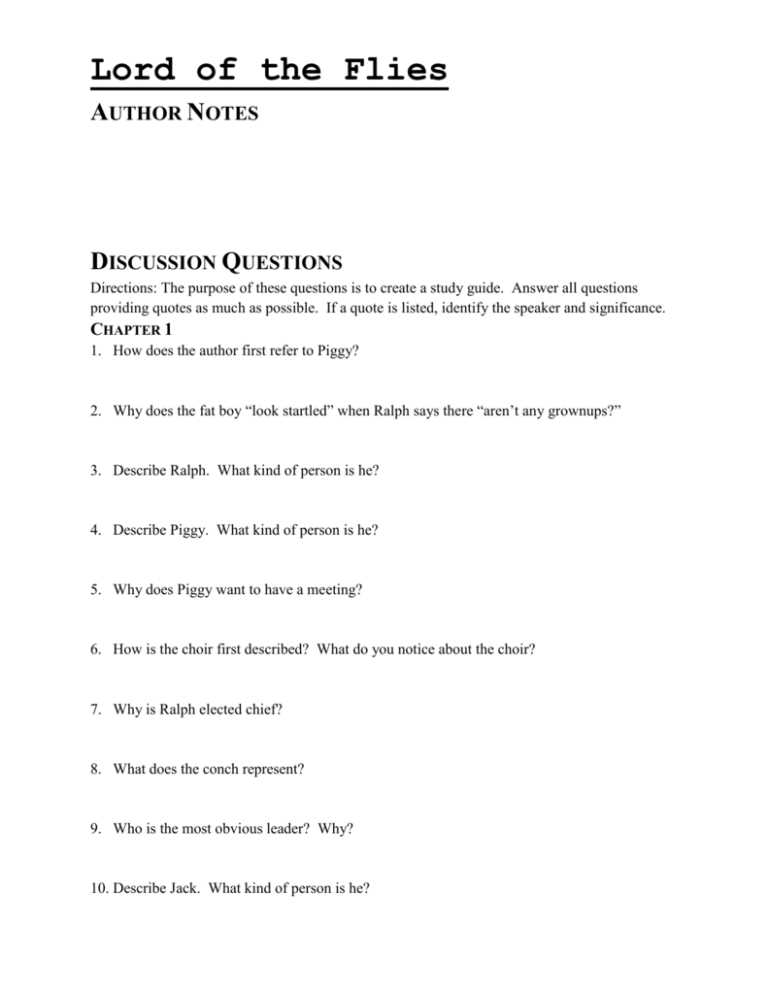
As the narrative progresses, Ralph’s role as a leader becomes increasingly challenging. In this section, his authority is tested by the growing chaos within the group. Despite his best efforts to maintain order and focus on survival, the boys’ fear and descent into savagery begin to undermine his leadership. Ralph’s struggle to hold onto rationality and establish a sense of security highlights the difficulty of governing when fear and emotional impulses take precedence over reason.
Throughout this part of the story, Ralph’s leadership is marked by a sense of isolation. While he remains committed to the ideals of civilization–such as building the signal fire and maintaining a structured approach to survival–he faces mounting opposition. Jack’s increasing dominance and the group’s shifting allegiances make Ralph’s position more precarious. The tension between maintaining order and responding to the primal fears of the boys sets the stage for greater conflicts and challenges ahead.
Jack’s Influence Over the Boys
As the story unfolds, Jack’s power and influence over the group intensify. His ability to manipulate the boys’ emotions, especially their fears, plays a crucial role in his increasing control. Jack’s leadership is built not on reason or organization, but on appealing to the boys’ baser instincts–offering a sense of security through dominance and savagery. His influence contrasts sharply with Ralph’s more structured approach, and it becomes clear that Jack’s grip over the group is growing stronger as fear and chaos take hold.
Jack’s Appeal to Fear
One of Jack’s primary strategies is exploiting the boys’ fear of the beast. By feeding into this fear, he strengthens his position as a leader of those who are desperate for protection and certainty. His use of fear for control is evident in several ways:
- Reassuring the boys that hunting will protect them from the beast
- Using fear to justify abandoning reason and embracing primal instincts
- Promoting the idea that strength and violence will secure their survival
Shifting Allegiances
As Jack’s influence grows, more boys begin to follow him, attracted to his promise of excitement and power. This shift in allegiance illustrates the breakdown of unity among the group, as fear and the lure of freedom from Ralph’s authority pull them in Jack’s direction. The transformation of the boys from cooperative members to followers of Jack highlights the fragile nature of leadership and the dangers of surrendering to fear and savagery.
The Growing Fear of the Beast

As the days pass on the island, an intense and growing sense of dread takes hold of the boys. What began as a vague fear of an unknown threat evolves into a dominating force, shaping their thoughts, actions, and decisions. This fear, magnified by the boys’ isolation and inability to explain their environment, becomes more than just a shared anxiety; it grows into a collective belief that something dangerous lurks nearby. This rising terror begins to distort their perception of reality, pushing the group further away from reason and closer to chaos.
The Beast as a Catalyst for Conflict
The idea of the beast quickly becomes a central concern for the group, stirring division and confusion. Some boys, like Ralph, try to maintain order and dismiss the idea as superstition, but others, particularly Jack and his followers, use the fear to manipulate and control. The more the boys focus on the existence of the beast, the less they focus on their survival and cooperation. It becomes an excuse for abandoning their established rules and giving in to their primal instincts.
Fear and Human Nature
At its core, the growing fear of the beast represents the deepening conflict between civilization and savagery. It becomes a reflection of the boys’ inner struggles–their growing inability to cope with fear without resorting to violence or irrationality. As the terror of the beast intensifies, the boys begin to lose touch with their moral compass, and the fear of the unknown transforms into a destructive force that consumes their reasoning and unites them in their most basic, primal impulses.
Symbolism of the Beast and Parachutist
Throughout the story, several key symbols emerge that deepen the themes of fear, power, and human nature. Two of the most significant symbols are the beast and the parachutist. Both are tied to the boys’ growing descent into savagery and the breakdown of their societal structure. While the beast represents the primal fears that lurk within every individual, the parachutist’s body becomes a symbol of lost hope and the violence of the outside world intruding upon their isolated existence. These symbols play crucial roles in illustrating the conflict between civilization and savagery, as well as the internal struggles each boy faces.
The Beast: Manifestation of Inner Fears
The idea of the beast takes on a life of its own in the boys’ collective imagination, growing stronger as their fear intensifies. Although no tangible creature exists, the beast becomes a symbol for the darkness and savagery that resides within each of them. It represents:
- The fear of the unknown, growing stronger in their isolation
- The boys’ inability to confront their own impulses and violent tendencies
- The breakdown of their moral compass as they struggle to survive
The Parachutist: A Symbol of Chaos and Corruption
In stark contrast to the beast, the parachutist’s body symbolizes the intrusion of the outside world into the boys’ isolated existence. When the parachutist’s body lands on the island, it is mistaken for the beast, reflecting how the boys’ perception of reality has become distorted. The parachutist represents:
- The violence and corruption of the adult world, now present in their isolated sanctuary
- The collapse of rational thought, as the boys project their own fears onto the lifeless figure
- The futility of escaping the real world, even in an isolated environment
Together, these two symbols reinforce the idea that the boys’ descent into chaos is driven not only by external circumstances but by their own internal conflicts. The beast and the parachutist serve as reminders of the fragile nature of civilization and the ease with which it can be undone by fear and violence.
The Role of the Conch in Leadership
The conch shell, a simple object found on the island, quickly becomes a powerful symbol of order and authority. Its role in the group’s leadership dynamic is pivotal, representing the structure of civilized society and the rules that bind the boys together. Initially, it is used to call meetings and establish a semblance of democratic control. However, as the group descends further into chaos, the conch’s influence begins to fade, mirroring the erosion of rational leadership and the rise of unchecked power.
The Conch as a Symbol of Authority
At the beginning, the conch is a tool for maintaining order and providing structure to the boys’ society. Ralph, as the leader, uses the conch to gather the group and establish a sense of fairness, allowing each boy a chance to speak during assemblies. Its role extends beyond mere communication–it represents:
- The rule of law and collective decision-making
- Respect for leadership and organized dialogue
- The attempt to create a structured society amidst the chaos of the island
The Decline of the Conch’s Power
As the boys grow more fearful and divided, the power of the conch starts to diminish. While initially a symbol of leadership and democracy, it gradually loses its influence, particularly as Jack’s group rejects the authority it represents. The object becomes a mere relic of a fading order, signifying:
- The collapse of cooperative society and the rise of individual power
- The boys’ increasing disregard for rules and authority
- The growing influence of fear and violence over reason
| Event | Impact on Leadership |
|---|---|
| Ralph using the conch to call meetings | Establishes order, giving all boys a voice |
| Jack rejecting the conch’s authority | Undermines structured leadership, shifts power to Jack |
| Conch shattering | Represents the complete breakdown of civilization and order |
The gradual loss of respect for the conch reflects the breakdown of rational leadership on the island. It highlights the shift from civilized discourse to savagery, marking the pivotal turning point in the boys’ journey from order to chaos.
Major Conflicts in Chapter 6
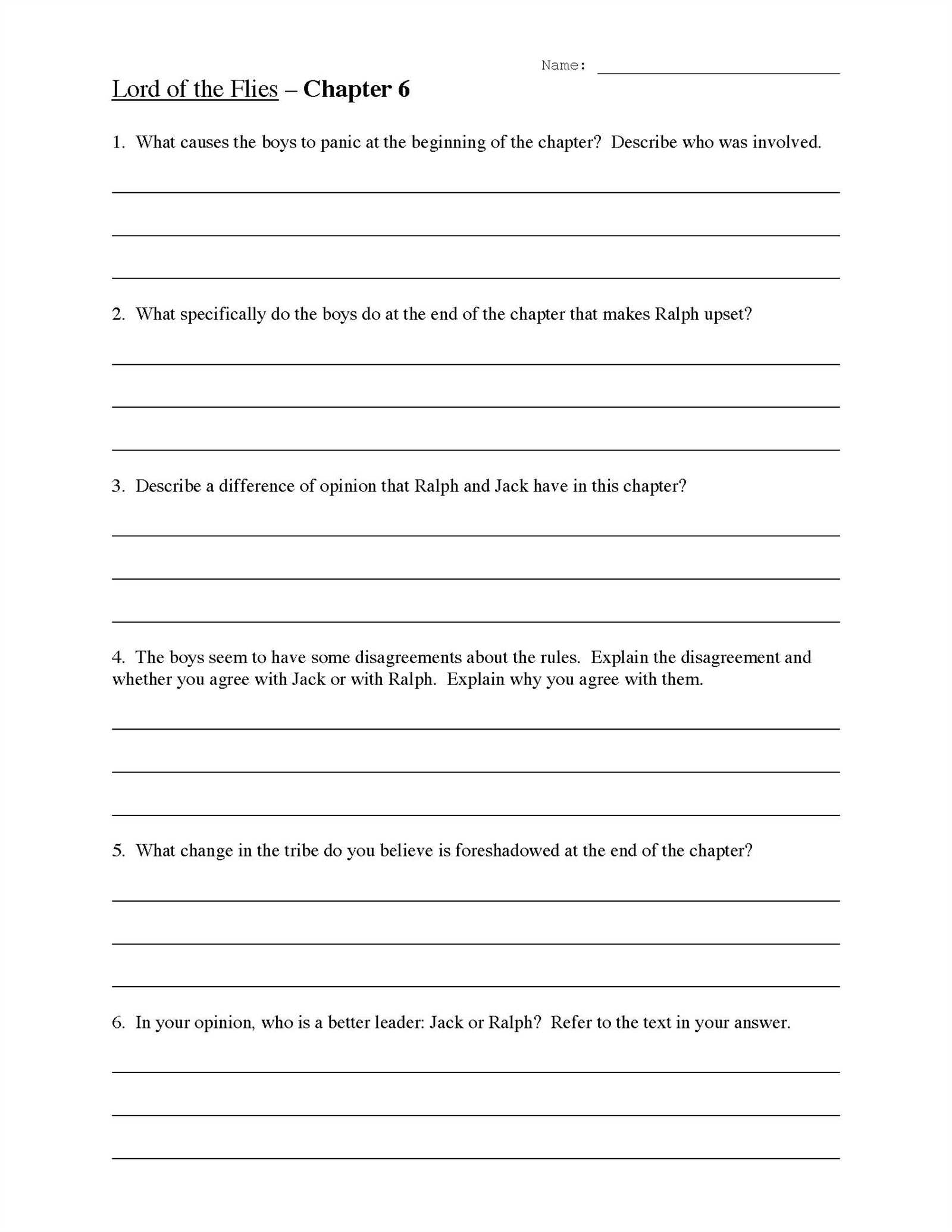
In this segment of the story, several critical tensions surface, propelling the narrative toward further chaos and division. The boys on the island are increasingly torn between their desire for order and the growing influence of fear and power struggles. These conflicts center around both internal struggles within the boys and external dangers that threaten their fragile society. As fear of the unknown deepens, alliances shift, and the lines between civilization and savagery become more blurred.
Fear of the Beast
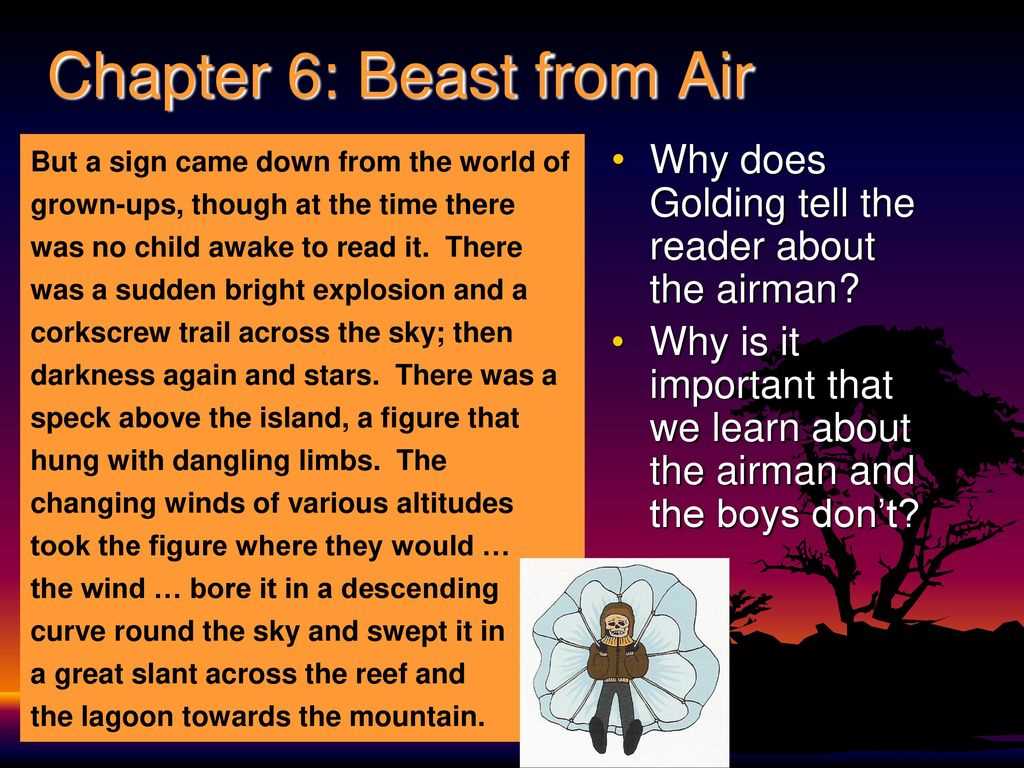
One of the most significant sources of tension is the escalating fear of a mysterious creature that seems to haunt the boys. This fear becomes a driving force behind many decisions, particularly influencing the actions of Ralph and Jack’s groups. The unknown “beast” becomes a symbol of the boys’ inner fears, and this growing terror exacerbates the already existing fractures between them. It leads to:
- Increased paranoia among the boys
- The split between those who still believe in the importance of order and those who give in to fear
- Ralph’s struggle to maintain leadership in the face of irrational beliefs
Ralph vs. Jack’s Power Struggle
The ongoing conflict between Ralph and Jack escalates, with each boy seeking control over the group. Ralph’s leadership, based on cooperation and maintaining order, is increasingly challenged by Jack’s appeal to primal instincts and the promise of safety through aggression. This rivalry grows throughout the segment as Jack’s group becomes more disillusioned with Ralph’s methods and leadership style, leading to:
- Ralph’s challenge in holding onto authority
- Jack’s rising power, fueled by his promises to eliminate threats and provide meat
- Division of the boys into rival factions, threatening the unity of the group
Internal Struggles of the Boys
Alongside external conflicts, the boys are also battling internal turmoil. Some are beginning to question their own roles in this fractured society, torn between their desire for safety, their longing for power, and their fear of the unknown. These inner conflicts contribute to:
- Feelings of isolation and vulnerability among certain characters
- The weakening of the group’s unity as individuals choose sides
- The growing tension between logic and emotion, as some resist fear-driven decisions
The culmination of these tensions in this section marks a turning point for the boys. As fear, power struggles, and internal conflicts escalate, the fragile fabric of their society begins to unravel, setting the stage for further chaos and violence.
How Fear Affects the Group Dynamics
Fear plays a pivotal role in shaping the behavior and interactions within the group. It acts as a catalyst for division, manipulation, and the breakdown of social order. As the boys’ fears intensify, their ability to cooperate deteriorates, and individual desires take precedence over collective well-being. The psychological effects of fear influence how alliances form, how leadership is contested, and how decisions are made, ultimately steering the group toward chaos.
Fear and Leadership Struggles
One of the most profound impacts of fear is on leadership dynamics. As anxiety over external threats grows, the boys’ faith in Ralph’s calm and rational leadership begins to erode. Jack’s appeal to primal instincts and his promise of protection from the unknown monster becomes increasingly attractive to the group. Fear becomes a tool for Jack to manipulate the others, offering false promises of safety and power. This shift causes:
- Ralph’s diminishing authority as fear clouds judgment
- Jack’s growing influence, fueled by exploiting the boys’ fear
- Rival factions emerging within the group, threatening unity
Fear and Group Behavior
As the group’s collective fear of an unseen creature intensifies, the boys become more susceptible to irrational thinking and groupthink. Their actions are dictated less by reason and more by collective panic. This heightened state of fear leads to:
- Increased disorder as individuals become more inclined to act on their fears rather than logic
- Separation between those who seek safety through rational behavior and those who give in to impulsive, fear-driven actions
- Escalating violence and conflict as fear magnifies emotions and amplifies the boys’ desires to dominate and protect themselves
Ultimately, fear transforms what was once a cooperative society into a fragmented and volatile group, where survival instincts overpower moral reasoning. This shift in group dynamics demonstrates the powerful influence that fear has over human behavior, especially in times of crisis.
Contrasting the Characters of Ralph and Jack
The contrasting personalities of Ralph and Jack are central to the conflict within the group, highlighting different approaches to leadership, survival, and power. While both characters possess strong leadership qualities, their methods and philosophies about governance and human nature diverge significantly. Ralph represents order, civilization, and collective well-being, while Jack embodies chaos, self-interest, and a descent into savagery. This tension between the two is a key theme, influencing both the group’s dynamics and the boys’ ultimate fate on the island.
Ralph’s Leadership and Values
Ralph’s leadership is rooted in a desire to maintain structure and order. He emphasizes the importance of rules, rational decision-making, and long-term survival. Ralph believes in working together as a cohesive unit to achieve common goals, such as building shelters and keeping the signal fire alive. His leadership style is democratic, as he seeks input from others and values cooperation. However, Ralph’s reliance on reason and his faith in the boys’ ability to cooperate face challenges as fear and chaos spread throughout the group. Key characteristics include:
- A focus on creating a society based on rules and organization
- A belief in hope and the possibility of rescue
- Rational, calm decision-making under pressure
- A commitment to the collective good, even at personal cost
Jack’s Leadership and Descent into Savagery
In stark contrast, Jack leads with a more authoritarian approach, valuing power, control, and instinct over reason and cooperation. He is quick to abandon civilized ideals in favor of more primal methods of survival, including hunting and the use of fear. Jack exploits the boys’ fear of an unseen monster to gain loyalty and manipulate them into following his lead. His leadership style is based on fear, violence, and the promise of protection, which ultimately appeals to the boys’ more savage instincts. Key traits of Jack’s character include:
- An obsession with power and dominance
- A tendency to use fear as a tool for manipulation
- Rejection of rules and authority in favor of personal gain
- A focus on self-preservation and individual strength over group harmony
As the story progresses, the contrast between Ralph and Jack becomes more pronounced, with Ralph’s ideals of order clashing against Jack’s pull toward anarchy and violence. This conflict is not only about leadership styles but also about the inherent nature of the boys and their responses to the challenges they face on the island.
The Boys’ Relationship with Nature
The boys’ interactions with their environment evolve throughout their time on the island, reflecting their growing disconnection from civilization and their descent into savagery. Initially, nature is a source of resources and beauty, but as fear and chaos grow, the boys’ relationship with the natural world shifts. Nature becomes both a sanctuary and a threat, embodying the boys’ inner turmoil and the external dangers they face. This dynamic illustrates their transformation and the influence of the untamed world around them on their behavior.
Initial Connection to the Environment
At the beginning of their time on the island, the boys approach nature with a sense of wonder and opportunity. They are resourceful, using the island’s natural resources to survive and maintain a semblance of order. The jungle provides food, water, and materials for shelter, while the beauty of the landscape serves as a temporary distraction from their predicament. Key aspects of their initial connection include:
- A sense of exploration and curiosity about the natural world
- Use of the environment for practical survival purposes, such as hunting and building shelters
- Admiration for the island’s untouched beauty
- Initial respect for the balance between man and nature
The Growing Fear and Hostility
As the boys’ fear of the unseen monster intensifies, nature begins to take on a more ominous role. The once serene jungle becomes a place of dread, with the boys imagining it as the home of the beast. This growing anxiety transforms the way they view their surroundings, from a nurturing force to a threatening and uncontrollable presence. Their fear is reflected in their behavior, as they begin to see nature as an adversary. Important developments include:
- Increased paranoia about the island’s wilderness and its hidden dangers
- Associating natural elements, like the dense forest, with the presence of the beast
- A loss of respect for the environment, as survival instincts and fear take precedence over harmony with nature
- Nature becoming a symbol of chaos and danger, rather than beauty and sustenance
By the end of their stay, the boys’ relationship with nature is no longer one of balance or respect. Their fear and increasing savagery warp their perception of the world around them, turning the island from a place of survival to a battleground where human nature clashes with the forces of the untamed wilderness.
How Chapter 6 Sets the Tone for the Novel
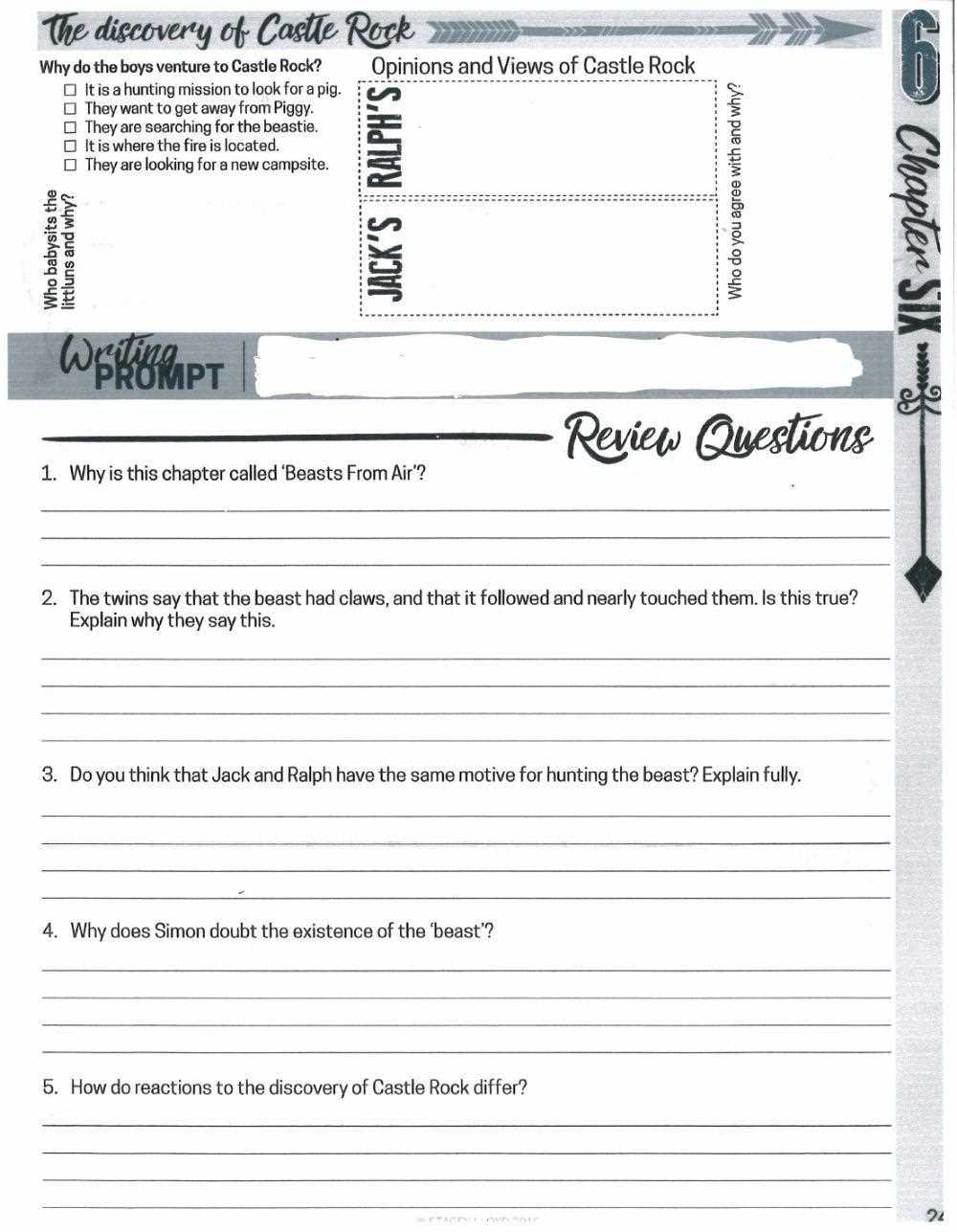
In this pivotal section of the narrative, the events that unfold significantly shape the atmosphere and direction of the story. A sense of growing tension and instability takes root, underscoring the fragile balance between civilization and savagery. As the boys’ fears deepen and their descent into chaos accelerates, this part of the story marks a crucial turning point. It introduces key elements that will influence the characters’ actions and set the stage for the inevitable conflict that lies ahead.
The chapter amplifies the ominous mood that has been developing since the beginning, emphasizing themes of fear, power, and the loss of innocence. As a result, the boys’ relationships with each other and their environment become increasingly strained. The tension between order and chaos, represented by the differing leadership styles of Ralph and Jack, reaches a new intensity, and the once idyllic island setting begins to transform into a place of hostility and dread.
Key aspects that contribute to the tone in this section include:
- Intensification of fear: The boys’ collective anxiety about the unseen “beast” fuels their descent into irrational behavior, marking the beginning of their psychological unraveling.
- Power struggles: Conflicts over leadership and differing views on survival strategies begin to intensify, foreshadowing future divisions.
- Loss of innocence: As fear overtakes rational thought, the boys’ transformation from children into more primal beings becomes more evident.
In essence, this section sets the tone for the novel by solidifying the central themes of human nature, the breakdown of social order, and the inescapable consequences of fear. It marks the moment when the boys’ descent into savagery becomes inevitable, establishing a dark, foreboding mood that will persist throughout the rest of the story.
Key Quotes from Chapter 6 Explained
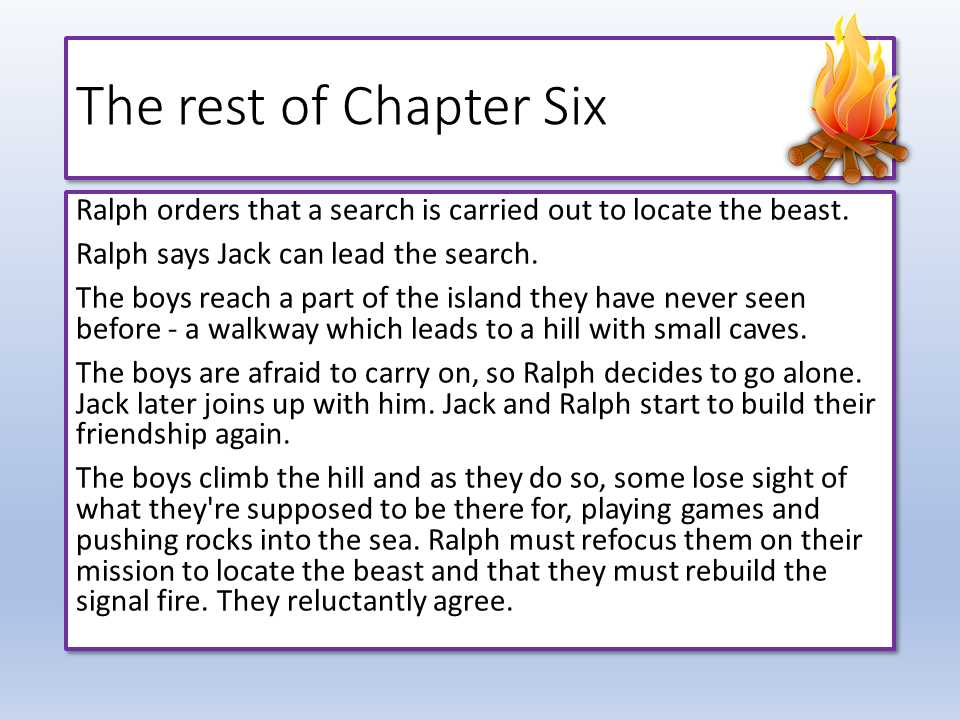
In this crucial part of the narrative, several powerful statements capture the emotions and evolving dynamics among the characters. These quotes serve as reflections of the psychological and social tensions that are escalating on the island. By examining these lines, we gain a deeper understanding of the themes of fear, power, and the loss of innocence, as well as the growing divide between the boys.
Below are some of the key quotes from this section, each with an explanation of its significance:
- “The beast was harmless and horrible; and the image of a beast might be traced through the children’s minds.”
This quote reflects the boys’ growing fear of an imagined creature, the “beast.” It shows how their terror has become an all-consuming force, turning a mere idea into something that has a tangible impact on their actions. The fear of the beast becomes symbolic of their descent into chaos and the darkness within themselves.
- “We’ll never be rescued. At least not so as we can be sure.”
Here, Ralph begins to express the doubt that he has been harboring about the boys’ chances of being saved. This marks a shift from optimism to a recognition of their increasingly dire situation. It highlights the isolation and hopelessness that have begun to take root, affecting their collective morale.
- “This head is for the beast. It’s a gift.”
Jack’s decision to offer a severed pig’s head as a gift to the imagined creature signifies the complete surrender to primal instincts. The act is a symbolic gesture of appeasement to the fear that controls the group. It also marks a departure from civilization and a deeper embrace of savagery.
- “The world, that understandable and lawful world, was slipping away.”
This quote encapsulates the disintegration of order on the island. As fear and chaos begin to dominate, the structured world that the boys once knew seems to fade, replaced by an unpredictable and increasingly dangerous environment. It highlights the breakdown of societal rules and the shift toward anarchy.
Each of these quotes serves to illustrate the escalating tension among the boys and their struggles with fear, leadership, and their diminishing connection to civilization. They reinforce the themes of internal conflict and the dangerous consequences of unchecked primal instincts. Through these words, we see how the boys’ initial sense of order is being overtaken by disorder and irrationality, setting the stage for the inevitable collapse of their society.